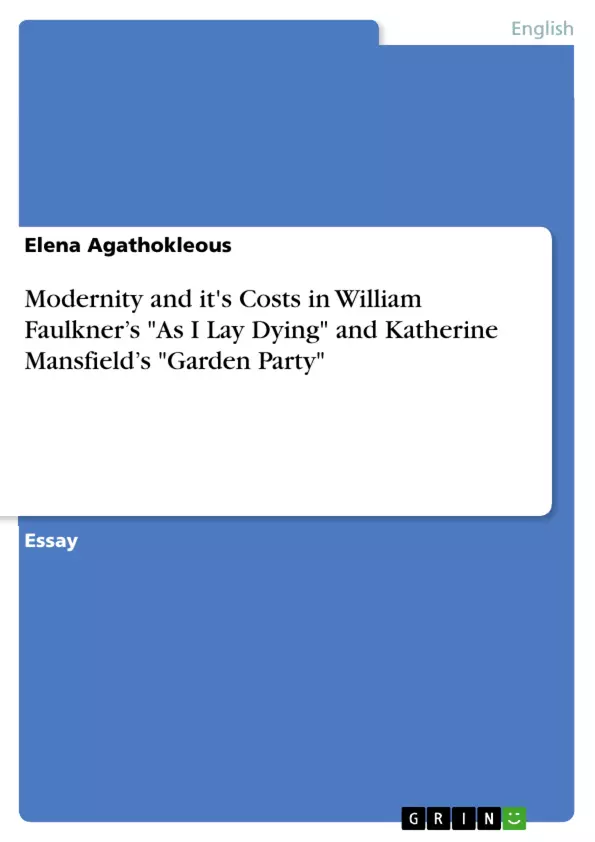This essay shows how Faulkner’s "As I Lay Dying" and Katherine Mansfield’s "Garden Party" are both modernist texts that deal with modernity and its costs for specific groups of people.
The time characterized as modernity was the time that major technological advancements were made and along with them there were also major changes in society and culture. Modernity was the period that new science was developed, politics and capitalism appeared and industrialization was an intense phenomenon.
Inhaltsverzeichnis (Table of Contents)
- The Costs of Modernity Through Faulkner’s As I Lay Dying and Mansfield’s Garden Party
- Modernism and its Costs
- Modernity in the American South
- Faulkner’s As I Lay Dying
- The Bundrens’ Resistance to Modernity
- Immobility and Fragmentation
- The Bundrens’ Superficial Relation to Modernity
- The Costs of Modernity: A Dead End Situation
- Mansfield’s The Garden Party
- The Social Hierarchy and the Class Struggle
- The Costs of Modernity for the Working Class
- The Impact of Modernity on the Family
- Conclusion
Zielsetzung und Themenschwerpunkte (Objectives and Key Themes)
This text examines the costs of modernity as experienced by specific groups of people, drawing on the works of William Faulkner's As I Lay Dying and Katherine Mansfield's The Garden Party. It explores how modernity, while bringing advancements and progress, also created significant social and economic inequalities, and left certain groups behind, struggling with alienation and injustice.
- The impact of modernization on different social groups and the emergence of inequalities
- The resistance to modernity and its implications for individual lives and communities
- The psychological and social costs of modernity, including fragmentation, immobility, and alienation
- The portrayal of modernity as a double-edged sword, offering opportunities for progress but also creating significant challenges
- The role of literature in exploring the human experience of modernity and its consequences
Zusammenfassung der Kapitel (Chapter Summaries)
The text begins by introducing the concept of modernity and its impact on society, highlighting the tensions between the old and new. It discusses the rise of modernism as a response to the destructive effects of modern capitalism and the suffering it caused, particularly for the working class. The text then delves into the specific context of modernity in the American South, examining how the abolition of slavery and the rise of industrialization brought about significant economic and social changes, leading to resistance and a sense of being stuck in a dead-end situation.
Faulkner's As I Lay Dying is analyzed as a modernist text that portrays the fragmented reality and immobility of the Bundren family, who represent those who are marginalized by modernity. The text highlights the Bundrens' inability to access the benefits of modernity and how they are trapped in a cycle of poverty and isolation.
The chapter on Mansfield's The Garden Party explores the social hierarchy and class struggle that emerged as a result of modernity. It analyzes how the story depicts the consequences of modernity for the working class, highlighting themes of exploitation, alienation, and the impact on family structures.
Schlüsselwörter (Keywords)
The key terms and concepts that underpin this text are: modernity, modernism, social inequality, economic exploitation, alienation, fragmentation, immobility, provincialism, industrialization, capitalism, the American South, Faulkner's As I Lay Dying, Katherine Mansfield's The Garden Party, working class, social hierarchy, family structure.
- Quote paper
- Elena Agathokleous (Author), 2021, Modernity and it's Costs in William Faulkner’s "As I Lay Dying" and Katherine Mansfield’s "Garden Party", Munich, GRIN Verlag, https://www.grin.com/document/1007710



